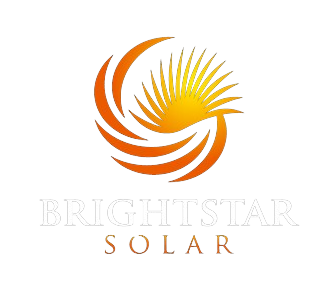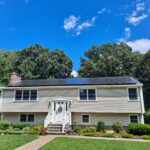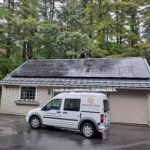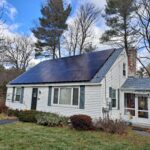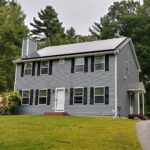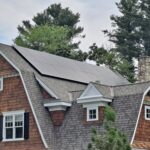The systems we build are grid-tied, meaning they connect to your home’s wiring and the utility’s network. You need to stay connected to the grid so you can buy power from the utility at night, when snow covers your panels for a day or two, and on cloudy days. Also, most of our installations cannot produce enough energy to fully power your home in the winter months. You will continue to receive an electric bill if you go solar.
Net metering is what allows you to stay connected to the grid for your safety and convenience and use the utility’s network as a virtual “battery”, sending power back to the grid when you’re producing a surplus (spinning the meter backward).
Here are four case studies of actual homes we’ve installed solar on.
The red line shows the home’s electricity use for each of the twelve months of the year before we installed solar. The green bars represent actual solar production since the system was turned on.
Case #1 shows a home with very typical consumption.
This home is getting virtually all of its annual electricity needs from solar, but you can see there are some months when the PV array produces a surplus of energy (March through July), and other months when consumption is greater than PV generation. The way that net metering works with Unitil, National Grid, Eversource, and many other electric utilities is that the customer would build up a large credit on their account during those summer months of surplus production. Starting in September, when the demand is slightly higher than production, the credit would be drawn down a bit to pay for the electricity purchased from the grid. Over the course of the whole year, this customer is paying just about nothing except their monthly basic customer fee (usually between $5 and $10).
Case #2 is our own home, where 79% of our electric power needs over the course of a year come from solar.
What is interesting about this graph is the huge difference between our 7 months of strong production (March through September) and the weaker months (October through February). Our home is surrounded by tall trees that cast some shade on the roof when the sun is riding lower in the sky. In the late winter and early spring we start to see massive increases in our production and our system really comes alive! This is the most extreme ratio of high-to-low monthly performance of any system we’ve installed.
We highlight a customer with electric heat in Case #3.
Although we built a large system for this home and it is performing very well, you can see it’s only delivering 38% of their annual electricity needs. Homes with electric heat use a lot of power to stay warm in the winter, as you can see by the height of the red line in the winter months (compare the red line to Case #1 or #2, which have very typical consumption patterns for conventionally-heated houses). Some prospective customers with electric heat are dismayed when they learn we can only offset 20-50% of their power. This family was not discouraged because they knew they were reducing their carbon footprint AND making a great investment. Look at it this way – we’ve installed commercial systems that make less than 5% of the onsite demand for electricity! “Is it worth it?” some ask… if you have a good site for solar it will be worthwhile whether you make 1% or 100% of your electricity.
Case #4 shows a home with a swimming pool, shifting their unusual peak demand to the summer (sort of the opposite of #3).
Over the full year this family made 110% of their electricity with solar. Why go too big? This family plans to buy an electric car in the near future and wanted to have a little extra capacity to “drive for free”.
How would your electric bill look after adding solar?
That’s a good question and one we can easily answer. Brightstar Solar is one of the leading Massachusetts solar companies building residential and commercial installations. Our company provides the above graph in our proposals to customers showing your expected solar production and your historical electricity usage by month. If you’re interested in solar panels for your Massachusetts home or business, please call us at 617-564-0050 or sign up for a free evaluation.

